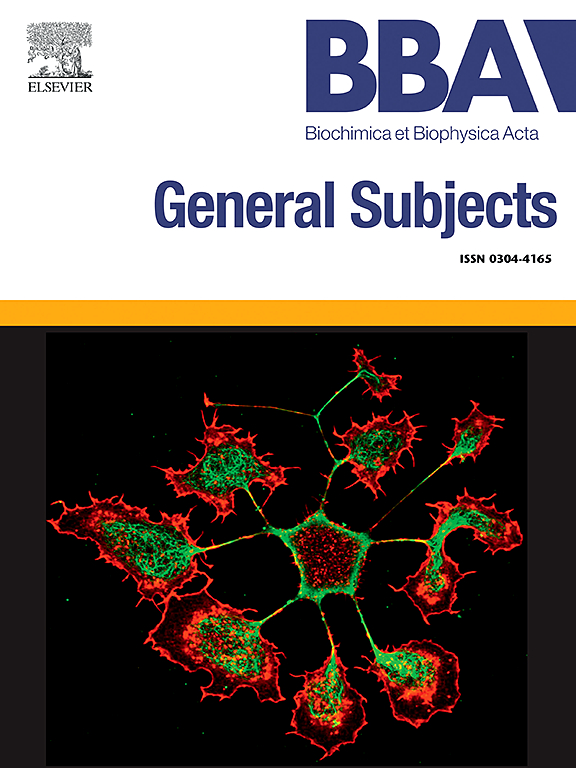在幼年巨噬细胞样THP-1细胞中,组蛋白乙酰化和BRD4结合与时间性高糖暴露和随后的低糖培养诱导TNF mRNA表达相关。
IF 2.8
3区 生物学
Q3 BIOCHEMISTRY & MOLECULAR BIOLOGY
Biochimica et biophysica acta. General subjects
Pub Date : 2025-01-13
DOI:10.1016/j.bbagen.2025.130759
引用次数: 0
摘要
背景:餐后高血糖诱导包括肿瘤坏死因子(TNF)在内的炎性细胞因子的表达,促进2型糖尿病和心血管疾病的发生。在这项研究中,我们研究了在人幼年巨噬细胞样THP-1细胞中,短暂的高糖培养是否增强了TNF的持续表达,或者这种诱导是否与组蛋白乙酰化和与乙酰化组蛋白结合的含溴结构域蛋白4 (BRD4)有关。方法:将THP-1细胞在含或不含(+)-JQ1的高糖培养基中培养24 h(第0天),然后将细胞返回不含(+)-JQ1的低糖培养基中培养2天或4天并收集样品。RT-qPCR和染色质免疫沉淀法分别检测炎症基因mRNA表达、组蛋白H3 K9/14乙酰化、BRD4和RNA聚合酶II在TNF基因周围的结合情况。结果:与在低糖培养基中培养的细胞相比,在高糖培养基中培养24小时、随后在低糖培养基中培养2-4天的细胞中,TNF mRNA水平、组蛋白H3 K9/14乙酰化、BRD4和RNA聚合酶II与TNF基因的结合更高。在高糖培养基中添加(+)-JQ1 24 h,可降低组蛋白H3 K9/14乙酰化、BRD4和RNA聚合酶II在TNF基因周围的结合以及mRNA水平。结论:组蛋白H3 K9/14乙酰化和BRD4结合与幼年巨噬细胞样THP-1细胞在时间性高糖暴露诱导的TNF mRNA持续表达有关。本文章由计算机程序翻译,如有差异,请以英文原文为准。
Histone acetylation and BRD4 binding are associated with induction of TNF mRNA expression by temporal high-glucose exposure and subsequent low-glucose culture in juvenile macrophage-like THP-1 cells
Background
Postprandial hyperglycemia induces expression of inflammatory cytokines including tumor necrosis factor (TNF), which promotes the onset of type 2 diabetes and cardiovascular diseases. In this study, we investigated whether a transient high-glucose culture enhanced sustained expression of TNF, or whether the induction is associated with histone acetylation, and bromodomain protein containing protein 4 (BRD4), which binds acetylated histone, in human juvenile macrophage-like THP-1 cells.
Methods
THP-1 cells were cultured in medium with high-glucose in the presence or absence of (+)-JQ1, an inhibitor of bromodomain and extra-terminal domain family, for 24 h (day 0). Thereafter, the cells were returned to a low-glucose medium without (+)-JQ1 and cultured for 2 or 4 days and samples were collected. mRNA expression of inflammation genes, and histone H3 K9/14 acetylation and binding of BRD4 and RNA polymerase II around the TNF gene were measured by RT-qPCR and chromatin immunoprecipitation, respectively.
Results
TNF mRNA levels, histone H3 K9/14 acetylation, and bindings of BRD4 and RNA polymerase II to the TNF gene were higher in cells exposed to high-glucose culture for 24 h and subsequently cultured in low-glucose medium for 2–4 days, compared with cells cultured in a low-glucose medium. The addition of (+)-JQ1 to the high-glucose medium for 24 h reduced histone H3 K9/14 acetylation, and BRD4 and RNA polymerase II bindings around TNF gene, and the mRNA levels.
Conclusions
Histone H3 K9/14 acetylation and BRD4 binding are associated with the sustained expression of TNF mRNA induced by temporal high-glucose exposure in juvenile macrophage-like THP-1 cells.
求助全文
通过发布文献求助,成功后即可免费获取论文全文。
去求助
来源期刊

Biochimica et biophysica acta. General subjects
生物-生化与分子生物学
CiteScore
6.40
自引率
0.00%
发文量
139
审稿时长
30 days
期刊介绍:
BBA General Subjects accepts for submission either original, hypothesis-driven studies or reviews covering subjects in biochemistry and biophysics that are considered to have general interest for a wide audience. Manuscripts with interdisciplinary approaches are especially encouraged.
 求助内容:
求助内容: 应助结果提醒方式:
应助结果提醒方式:


